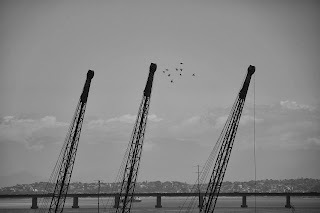Saturday, 30 November 2013
Tuesday, 26 November 2013
Saturday, 23 November 2013
Ahu Akivi
This enigmatic ahu is also called “7 moai”, and it is located northwest of Hanga Roa, near the underground network Te Pahu. The seven moai look into the faraway ocean (unlike the rest of the statues that always face the island in order to protect the clans with their Mana). Nobody knows with certainty the exact role of this ceremonial place, though many believe it was used by the island’s astronomists. The moai are lined up with their back to the eastern sun, oriented according to the solar line of the equinox. A minute ahu observes them from the other side of the plain.
Marcadores:
Rapa Nui - Easter Island
Local:
Easter Island, Chile
Saturday, 16 November 2013
La Lanterna
The Lanterna, symbol of Genoa and most important lighthouse of the city, is a 77-metre-high tower, made of two blocks, square in section, roughly of the same height, and both with a projecting terrace.
Built on a rock of 40 metres of height, the top of the Lanterna stands therefore at 117 metres above the sea level. Its light is visible from more than 50 kilometres away.
The Lanterna has welcomed vessels and boats and guided them into the harbour for centuries. The Lanterna, as we see it today, was built in 1543; unofficial sources, however, date back to 1128 the building on this site of the first tower intended to assist navigators.
Today visitors can climb 172 steps, reach the first terrace (76 m above the sea level), and enjoy the breathtaking view of the port and the old city.
Built on a rock of 40 metres of height, the top of the Lanterna stands therefore at 117 metres above the sea level. Its light is visible from more than 50 kilometres away.
The Lanterna has welcomed vessels and boats and guided them into the harbour for centuries. The Lanterna, as we see it today, was built in 1543; unofficial sources, however, date back to 1128 the building on this site of the first tower intended to assist navigators.
Today visitors can climb 172 steps, reach the first terrace (76 m above the sea level), and enjoy the breathtaking view of the port and the old city.
Font:
www.liguri.org/lanterna/lighthouse.asp
Tuesday, 12 November 2013
Saturday, 9 November 2013
Parque Nacional Tierra del Fuego
Located in southwestern Tierra del Fuego province, over the borderline with Chile, this National Park is the southernmost exemple of the Andean - Patagomiam forest. It was created in 1960 and has surface of 63.000 hectares.
In this area the final part of the Andes features a northwest – southeast orientation. The peaks alternate with valleys where there are rivers and glacial originated lakes. Two types of forests predominate here: those of Lenga and Guindo trees, with an open underwood mainly consisting of moss and fern.
In the spaces within the forests there is plenty of peat in very humid, flooded areas where the sphagnum moss grows.
On the sea shore, the two great bays (Lapataia and Ensenada) deploy in gorges and beaches that are full of white cauquenes. There are also black eyebrowed albatross (over two meters long) who cohabit with the steam duck and the diving petrel. There is also a rare kind of otter named chungungo.
Other species are the guanaco and a particular Tierra del Fuego variety of red fox. The Canadian beaver, an introduced species, has caused a great environmental impact because it cuts down trees in order to build dams which, in turn, provoke floods in certain parts of the forest where the trees also die as a consequence of the excess of water.
A bit of history
The primitive inhabitants of this region were the yámanas aborigines who lived in huts at the Lapataia Bay area. Their food was mainly seafood. Nowadays it is possible to spot the “concheros”, circles where mollusks accumulated meaning that there were settlements around.
Sightseeing - Activities
The are many trekking paths inside the Park, that can be easily followed:
Black Lagoon: Only 400m. from Route 3 yuo arrive to this lagoon, wich is dark colored due to the presence of peat.
The Island: it consists of 800 m. along the coasts of rivers Lapataia and Ovando, over archipelago Cormoranes.
The Lookout Point: From route 3 you directly access Lapataia Bay, walking along a lengas wood. From there you get to the lookout point which offers a magnificent panoramic view of the bay.
Meet the beavers: After some 400 m. up to Los Castores stream, you will be able to observe the dams system these incredible animals have built, as well as the environmental impact it causes.
Tuesday, 5 November 2013
Subscribe to:
Posts (Atom)




















































